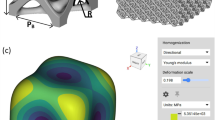Abstract
Additive manufacturing (AM) techniques are widely involved in the production of lattice-based prosthetic devices. Nevertheless, the development of implants with improved fatigue resistance is still an open debate. In lattice structures, the fatigue life of a component is a crucial issue, since it is not only strongly affected by the wide variety of manufacturing-induced defects but also by the specimen building direction. To gain a better comprehension of fatigue in AM, an investigation of sub-unit lattice elements according to their building orientation should be addressed. Additionally, this knowledge can be exploited to design a fatigue-optimized component. In this work, the authors propose a combined approach of fatigue experimental tests on sub-unit lattice elements along with optimization strategies for a wise design and fabrication of a Ti6Al4V laser powder bed fusion (L-PBF) octet truss lattice component. The specimen orientation with respect to the printing plane is chosen as the optimization variable.
Similar content being viewed by others
Abbreviations
- AM :
-
Additive manufacturing
- FE :
-
Finite element
- HC :
-
High cycle fatigue regime
- LC :
-
Low cycle fatigue regime
- L-PBF :
-
Laser powder bed fusion
- OT :
-
Octet truss
- SLP :
-
Sequential linear programming
- SEM :
-
Scanning electron microscopy
- γ :
-
Rotational coordinate around the X axis
- ψ :
-
Rotational coordinate around the Y axis
- σ a :
-
Stress amplitude
- N f :
-
Cycles to failure
References
A. du Plessis et al., Properties and applications of additively manufactured metallic cellular materials: a review, Prog. Mater Sci., 125 (2022) 100918, https://doi.org/10.1016/j.pmatsci.2021.100918.
M. Benedetti, A. du Plessis, R. O. Ritchie, M. Dallago, S. M. J. Razavi and F. Berto, Architected cellular materials: a review on their mechanical properties towards fatigue-tolerant design and fabrication, Mater Sci. Eng. R. Reports, 144 (2021) 100606, https://doi.org/10.1016/j.mser.2021.100606.
S. Murchio et al., Additively manufactured Ti-6Al-4V thin struts via laser powder bed fusion: Effect of building orientation on geometrical accuracy and mechanical properties, J. Mech Behav Biomed Mater (2021) 119, https://doi.org/10.1016/j.jmbbm.2021.104495.
T. Persenot, A. Burr, G. Martin, J. Y. Buffiere, R. Dendievel and E. Maire, Effect of build orientation on the fatigue properties of as-built electron beam melted Ti-6Al-4V alloy, Int. J. Fatigue, 118 (2019) 65–76, https://doi.org/10.1016/j.ijfatigue.2018.08.006.
T. Persenot et al., Fatigue performances of chemically etched thin struts built by selective electron beam melting: experiments and predictions, Materialia, 9 (2020) 100589, https://doi.org/10.1016/j.mtla.2020.100589.
M. Kahlin et al., Improved fatigue strength of additively manufactured Ti6Al4V by surface post processing, Int. J. Fatigue, 134 (2020) 105497, https://doi.org/10.1016/j.ijfatigue.2020.105497.
H. Soyama and F. Takeo, Effect of various peening methods on the fatigue properties of Titanium alloy Ti6Al4V manufactured by direct metal laser sintering and electron beam melting, Materials (Basel) (2020) 13, https://doi.org/10.3390/ma13102216.
G. Savio, R. Meneghello and G. Concheri, Optimization of lattice structures for additive manufacturing technologies, Lect Notes Mech Eng. (2017) 213–222, https://doi.org/10.1007/978-3-319-45781-9_22.
X. Wang, L. Zhu, L. Sun and N. Li, Optimization of graded filleted lattice structures subject to yield and buckling constraints, Mater Des, 206 (2021) 109746, https://doi.org/10.1016/j.matdes.2021.109746.
R. R. Fernandes and A. Y. Tamijani, Design optimization of lattice structures with stress constraints, Mater Des (2021) 210, https://doi.org/10.1016/j.matdes.2021.110026.
P. W. Christensen and A. Klarbring, An Introduction to Structural Optimization, Springer Science and Business Media, 153 (2008).
S. Murchio et al., On the effect of the node and building orientation on the fatigue behavior of L-PBF Ti6Al4V lattice structure sub-unital elements, Mater Des Process Commun, 3 (2021) 1–9, https://doi.org/10.1002/mdp2.258.
V. S. Deshpande, M. F. Ashby and N. A. Fleck, Foam topology bending versus stretching dominated architectures, Acta mater, 49 (2001) 1035–1040, https://doi.org/10.1016/S1359-6454(00)00379-7.
V. S. Deshpande, N. A. Fleck and M. F. Ashby, Effective properties of the octet-truss lattice material, Journal of the Mechanics and Physics of Solids, 49 (2001) 1747–1769, https://doi.org/10.1016/S0022-5096(01)00010-2.
B. Lozanovski et al., Non-destructive simulation of node defects in additively manufactured lattice structures, Addit Manuf, 36 (2020) 101593, https://doi.org/10.1016/j.addma.2020.101593.
K. W. Lee, S. H. Lee, N. H. Noh, J. Y. Park, J. Y. Cho and S. H. Kim, Theoretical and numerical analysis of the mechanical responses of BCC and FCC lattice structures, Journal of Mechanical Science and Technology, 33 (5) (2019) 2259–2266, https://doi.org/10.1007/s12206-019-0427-6.
Acknowledgments
This project has received funding from the Italian Ministry for Education, University, and Research (MIUR) within the program “Departments of Excellence” 2018–2022 (DII-UNITN) and through the REGENERA project.
Author information
Authors and Affiliations
Corresponding author
Additional information
Raffaele De Biasi is currently working on lattice structures and structural optimization at the University of Trento (Italy) as part of his Ph.D. research. In 2020, at the University of Trento, he completed his master’s degree in Mechanics and Mechatronic Engineering.
Simone Murchio is a Ph.D. student in Materials, Mechatronics, and Systems Engineering at the University of Trento, Italy. His research is focused on smart hierarchical cellular materials with improved fatigue resistance and osseointegration. He received his master’s degree in Materials and Production Engineering in 2019 at the University of Trento.
Matteo Benedetti is an Associate Professor at the University of Trento, Italy. He has a 20 years of experience in the field of mechanics of metallic materials, fatigue and fracture, finite element modeling, surface treatments, and residual stresses. He was a visiting researcher at the Technical University Hamburg-Harburg, where he studied the fatigue and fracture mechanisms of titanium alloys. Since 2015 he has been investigating the fatigue-related issues of additively manufactured materials with a special focus on lattice cellular biomaterials.
Rights and permissions
About this article
Cite this article
De Biasi, R., Murchio, S. & Benedetti, M. Structural optimization of lattice cellular structures: incorporating the fatigue strength dependency on the building orientation of sub-unit struts. J Mech Sci Technol 37, 1097–1102 (2023). https://doi.org/10.1007/s12206-022-2105-3
Received:
Revised:
Accepted:
Published:
Issue Date:
DOI: https://doi.org/10.1007/s12206-022-2105-3




